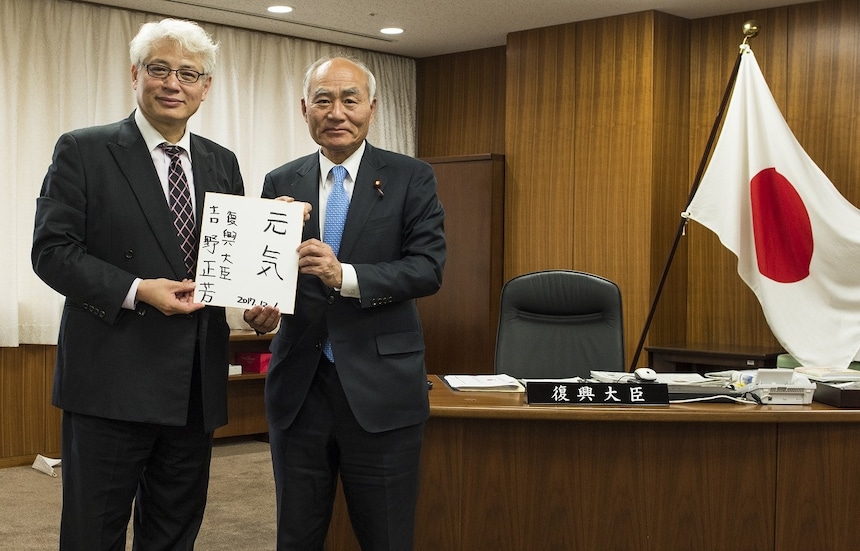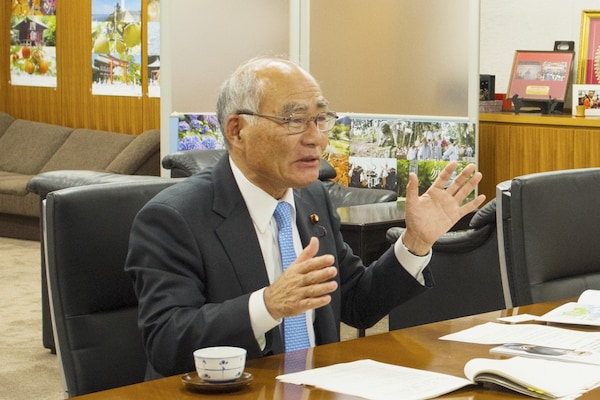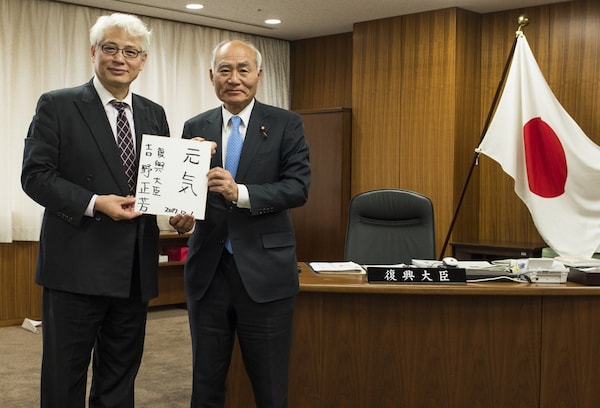The Restoration of Fukushima Is My Duty

On December 1, 2017, Jiang Feng, Editor-in-Chief of the People's Daily Overseas Edition Japan Monthly, walked across a carpet woven with a golden gingko motif to visit the office of Masayoshi Yoshino, Minister for Reconstruction, at the Reconstruction Agency in Kasumigaseki, the nucleus of the Japanese government. Read on for the full interview.

Since the March 11, 2011 Great East Japan Earthquake, I have been to Fukushima many times for reporting. This time, on September 11, 2017, some six and a half years since the disaster, I was invited as a Chinese media editor-in-chief to visit the Fukushima Daiichi Nuclear Power Station, the site of the nuclear accident.
Prime Minister Shinzo Abe has visited this site twice before. When the Cabinet was restructured at the beginning of August 2017, Prime Minister Abe said: “All Cabinet ministers should act as Ministers for Reconstruction,” though of course there is only one person specifically appointed to that position.
That person is Masayoshi Yoshino, a member of the lower House of Representatives. Mr. Yoshino hails from Fukushima, which sustained the triple blow of an earthquake, tsunami, and nuclear accident. The tsunami destroyed his office while his home was also partially destroyed. He has made it his mission to convey the needs of Fukushima residents to the national government and does not shy from expressing objection to Prime Minister Abe.
Radiation levels are largely the same as the world’s major cities

-- It has been 29 years since I came to Japan. You have been in politics for 30 years, correct? I recently reported on the Fukushima Daiichi Nuclear Power Station this past September and reporting on that subject has drawn major attention in China. I would like to begin by asking you about an issue Chinese people are keenly interested in. Is it reasonable to compare the airborne radiation levels in Fukushima and the environs to those of the world’s major cities?
Yoshino: Firstly, allow me to express my gratitude to you for conveying the realities of the Fukushima Daiichi accident to the Chinese people.
Decontamination of the environs around Fukushima Daiichi has made progress, and airborne radiation levels in an 80-kilometer radius from the plant as of October 2016 have decreased by 71 percent since November 2011.
If you compare current air dose rates at Fukushima with the world’s major cities, there is little difference. The air dose rate in Beijing as of September 4, 2017, was 0.07 microsieverts/hour. Air dose rate for Singapore on the same day was 0.10 microsieverts/hour; for Berlin, 0.08 microsieverts/hour; and for New York, 0.06 microsieverts/hour. Airborne radiation in Seoul on the following day was 0.12 microsieverts/hour. I am from the city of Iwaki in Fukushima, and the air dose rate there on August 1, 2017, was 0.06 microsieverts/hour, making it lower than Beijing.
Japan has the most stringent tests on radioactive substances in food
-- The EU recently announced plans to lift a ban on imports of agricultural, fish, and forest products (including rice) from ten of Japan’s prefectures, and this goes into effect as of today, December 1. Does the EU’s decision imply that these products from Fukushima are no longer contaminated by radioactive substances? How many countries have currently lifted similar bans?
Yoshino: After the Fukushima Daiichi accident, 81 countries and regions imposed restrictions on imports of these products. Thus far, 25 have lifted them (as of November 2017). This year alone, Qatar, Ukraine, Pakistan, and Saudi Arabia lifted their restrictions.
As a matter of fact, today is one of the happiest days for me. Today (December 1, 2017), the EU is lifting restrictions on imports of forest, fish, and agricultural products, among them rice, from 10 of Japan’s prefectures. (Ed: Argentina later also lifted its restrictions to make 26 total countries and territories.)
Unfortunately, however, seven countries and regions in Japan’s immediate environs, including China, Macau, South Korea, Singapore, and Russia, still have restrictions of some sort in place.
They perhaps have the impression that rice from Fukushima is the most contaminated worldwide. However, Japan’s standards on testing of radioactive substances in food are among the world’s most stringent. The Japanese Ministry of Health, Labour, and Welfare stipulates that radioactive substances cannot exceed 100Bq for 1kg of food. Since the allowable amounts in the EU and US are 1,250Bq and 1,200Bq, respectively, that makes Japan’s standard one-tenth of those amounts. In 2012, Japan was the first country to launch inspections of all bags of rice. Since 2015, rice from Fukushima has never exceeded the threshold. International organizations like the International Atomic Energy Agency (IAEA) and Food and Agriculture Organization (FAO) have highly appraised Japan’s strict food safety management and monitoring systems.
The most painful blow: reputational damage to Fukushima’s children

-- Since the 2011 nuclear reactor incident, “negative reputation impact” has become something of a buzzword around Asia. This term refers to baseless rumors having a negative economic effect or damaging the reputation of different parties, and the phenomenon has become well-known in China. I know that the Japanese government has utilized the press as a means of launching various strategies to promote understanding. What effects has this had?
Yoshino: The main cause of this reputational damage is a misunderstanding of how radiation works. In order to have people properly understand radiation and where Fukushima currently stands today, the Reconstruction Agency has produced intuitive pamphlets in multiple languages, among them Chinese, and is raising awareness in order to do away with this misguided image.
The key issue is how to restore revenue of Fukushima’s agriculture, forest, and fish products. Even though it has been six years and eight months since the reactor incident, Fukushima’s products are still lower priced than the national average. 93 percent of fish processing facilities are back online. Yet shelves in Tokyo’s supermarkets are constantly stocked with items from other regions, and Fukushima produce is increasingly unseen. In our position as the Reconstruction Agency, we intend to allocate a budget to helping Fukushima expand the sales routes of its locally-produced products. The tourism industry has also sustained a major blow from this reputational damage. We travel the world to give lectures on Fukushima’s current conditions and invite people to visit. In 2016, 50 percent more inbound tourists stayed in Fukushima than in the year prior, so we are seeing a rebound there. However, this cannot compare to the success Japan’s other regions are seeing.
Of all the various types of reputational damage, the most painful to me is the damage to Fukushima’s children who have had to evacuate to other prefectures, as some have been made to feel like outcasts or have been bullied.
Both reconstruction policy for the 'hard' aspect of infrastructure and approaches to the 'soft' aspect of caring for people's wellbeing
-- We touched on this a bit earlier, but what is the current progress of reconstruction in the six years and eight months since the earthquake, tsunami, and nuclear accident? How many people had to evacuate?
Yoshino: At the peak in June 2012, there were 164,000 evacuees across Fukushima. Now there are currently 53,000 evacuees. This is one-third of the peak number, but it does mean that there are no fewer than 53,000 people who lack a permanent residence. Going forward, we plan to specifically focus on this aspect.
Fukushima is 13,783 square kilometers in area. The evacuated region is 370 square kilometers, or just 2.7 percent of the total landmass (which is about the same size as six Manhattan Islands). In other words, 97.3 percent of Fukushima is suited to normal life. As of June 30, 2017, 85 percent of 30,000 new residences slated for construction have been built, with the number expected to reach 96 percent within the year.
In addition to supporting people to compensate for the physical and economic loss, psychological care is also key. Seven years have passed since the tsunami, and it has been seven months since I assumed my position as Minister of Reconstruction. However, when footage of the tsunami appears on television, I quickly change the channel. My home was hit by the tsunami, and I lost friends. While they say that time heals wounds, the shock of that time comes back time and again, and you relive it. This is something that I have personally felt, so I know that other victims feel the same way. It is not just about the infrastructure of supporting industry, building homes, and repairing levees. The intangibles of care and healing are also essential.
Emphasizing one’s own opinions inside the Cabinet
-- Let me end with a personal question. As a native of Fukushima, I’m sure you feel strongly about the area. At a lower house budget committee meeting, you stated that the majority of the responsibility for the Fukushima Daiichi nuclear accident is in the national government’s hands. On another occasion, you stated that Japan must aim to rid itself of nuclear power. These remarks may seem at odds with Prime Minister Abe’s own. How do you plan to persuade him?
Yoshino: As a Cabinet minister, the initiatives I take have to be congruent with the Prime Minister’s own. However, the people of Fukushima want to not only decommission the Daiichi plant, but also the Daini plant. Since I am a member of the Cabinet, I want to act as a Fukushima-born politician to convey locals’ needs to the national government. Even if those needs may be a minority opinion, I still consider it my responsibility to do so and reflect the needs of Fukushima’s residents in national government policy. I consider the reconstruction of Fukushima to be my personal duty.
Postscript

Upon concluding the interview, Minister Yoshino again thanked me for reporting on the realities of the nuclear accident to people in China. As the conversation transitioned to my authoring and publishing of the Chinese-language version of a biography of Toshihiro Nikai, he said, “The contributions Mr. Nikai made to Sino-Japanese relations are immeasurable. He has a deep relationship with China. I hope you will share his work and the story of Fukushima’s reconstruction with people in Japan and China alike.”



